PM sent. To initiate a "conversation" (PM) click on the user name in the Avatar and a box opens with options. One is for conversations.
GOES 16 GRB downlink vs GVAR
- Thread starter GOES 12 GVAR user
- Start date
- Latest activity Latest activity:
- Replies 713
- Views 108K
You are using an out of date browser. It may not display this or other websites correctly.
You should upgrade or use an alternative browser.
You should upgrade or use an alternative browser.
******************Here are some screenshots of the other polarity of the GOES-17 spectrum.
This signal is about 0.6 dB weaker. It took several coax resets before it would lock.
View attachment 132875 View attachment 132876 View attachment 132877
What software program are you using with your SDR to display the characteristics of the GRB RF signal ?
What SDR software programs are recommended for displaying the characteristics of the GRB RF signal ?
Speaking of GRB signal processing and display software, NOAA points to the Univ of Wisconsin hosted software suite for GOES GRB processing and display: The info at this site appears to be quite dated and I do not see any reference to updates.
The forum says my reply is spam and will not let me post it. I have tried to reword it several times with no success. It appears that the URL link I provided is the cause of this. The U of Wisc SSEC has a page on downloading GOES GRB software.
Speaking of GRB signal processing and display software, NOAA points to the Univ of Wisconsin hosted software suite for GOES GRB processing and display: The info at this site appears to be quite dated and I do not see any reference to updates.
The forum says my reply is spam and will not let me post it. I have tried to reword it several times with no success. It appears that the URL link I provided is the cause of this. The U of Wisc SSEC has a page on downloading GOES GRB software.
I used an AirSpy SDR running "SpectrumSpy". It allows you to view a larger band of spectrum than the SDR is normally capable of. It does this by rapidly switching the center frequency.What SDR software programs are recommended for displaying the characteristics of the GRB RF signal ? ...
The low cost RTL-SDR dongles display a maximum of about 2 MHz of bandwidth, so I would not recommend them for this purpose.
The page Magic Static linked to is for the whole system (hardware and software). The page dedicated to CSPP-GEO software is here: CSPP Geo, CIMSS...
Speaking of GRB signal processing and display software, NOAA points to the Univ of Wisconsin hosted software suite for GOES GRB processing and display: The info at this site appears to be quite dated and I do not see any reference to updates.....
It is currently in development. Recently, "GOES 12 GVAR User" suggested a new feature for their software (direct BB Frame ingestion) and I gave them some of the implementation details.
Hi Mike,
Weather01089 is in Mass. and he is using a 10' to get both streams there. You can get it on a 8' dish due to the prox. to the satellite.
Though there are factors that can change that.
My questions for you are:
1: What feed are you using?
In much detail as you can provide..
I know you mentioned that you have a patch antenna in a past post.
2: Is it circular polarized?
For now that's all I can think of.
In post #9 on page 1 I put up spectrum plots of the GRB signal. I was getting a 12.2 dBm above noise with a vertical polarized feed. So that can give some idea on mins. but it won't tell if the signal is usable on that.
The only way to know if the signal is usable is by getting a DVB-S2 Generic receiver that can decode the streams. This has been one of the bigger problems of this as the receivers don't seem to be set up for this type of use even though they are DVB-S2 type.
If I am wrong about this anyone please correct me.
For Magic Static, You could probably get the signal on a 10' dish there. These are assumptions though as conditions my change that.
As the both of you know I am having my own issues here, regardless of that I do have a 8dB C/N signal which is strong as KWX, and N6BY out in Cal.
You say you are in Micanopy Fl, you can get that signal with an 8' dish. If you go to a 10' dish then you will have even more margin.As expected I am not getting near enough GRB signal with my 8' dish (see attached) so am searching for a 12' replacement.
Weather01089 is in Mass. and he is using a 10' to get both streams there. You can get it on a 8' dish due to the prox. to the satellite.
Though there are factors that can change that.
My questions for you are:
1: What feed are you using?
In much detail as you can provide..
I know you mentioned that you have a patch antenna in a past post.
2: Is it circular polarized?
For now that's all I can think of.
In post #9 on page 1 I put up spectrum plots of the GRB signal. I was getting a 12.2 dBm above noise with a vertical polarized feed. So that can give some idea on mins. but it won't tell if the signal is usable on that.
The only way to know if the signal is usable is by getting a DVB-S2 Generic receiver that can decode the streams. This has been one of the bigger problems of this as the receivers don't seem to be set up for this type of use even though they are DVB-S2 type.
If I am wrong about this anyone please correct me.
For Magic Static, You could probably get the signal on a 10' dish there. These are assumptions though as conditions my change that.
You forgot to mention expensive as well...I think there is an unwritten rule that everything you really want has to be as far away as possible.
As the both of you know I am having my own issues here, regardless of that I do have a 8dB C/N signal which is strong as KWX, and N6BY out in Cal.
Should say:These are assumptions though as conditions my change that.
These are assumptions though as conditions may change that.
**************Hi Mike,
You say you are in Micanopy Fl, you can get that signal with an 8' dish. If you go to a 10' dish then you will have even more margin.
Weather01089 is in Mass. and he is using a 10' to get both streams there. You can get it on a 8' dish due to the prox. to the satellite.
Though there are factors that can change that.
My questions for you are:
1: What feed are you using?
In much detail as you can provide..
I know you mentioned that you have a patch antenna in a past post.
2: Is it circular polarized?
For now that's all I can think of.
In post #9 on page 1 I put up spectrum plots of the GRB signal. I was getting a 12.2 dBm above noise with a vertical polarized feed. So that can give some idea on mins. but it won't tell if the signal is usable on that.
The only way to know if the signal is usable is by getting a DVB-S2 Generic receiver that can decode the streams. This has been one of the bigger problems of this as the receivers don't seem to be set up for this type of use even though they are DVB-S2 type.
If I am wrong about this anyone please correct me.
For Magic Static, You could probably get the signal on a 10' dish there. These are assumptions though as conditions my change that.
You forgot to mention expensive as well...
As the both of you know I am having my own issues here, regardless of that I do have a 8dB C/N signal which is strong as KWX, and N6BY out in Cal.
Hi-- In response to your questions:
1) I have a couple of different feeds. The spectrum analyzer screen photos of the GRB and EMWIN RF signals I posted were made with a linear polarized feed. It is a home-brew copy of a commercial feed (by Seavy Engineering, Subsidiary of Antenna Research Associates, Inc) originally intended for the NOAA polar orbit met-sat birds. Essentially it is a balanced dipole where the coaxial balun is integral to the feed. See attached photos. I built it for downlinking the NOAA polar orbit birds such as NOAA-15, NOAA-16, and NOAA-18 with a 5-ft prime focus dish ( f/D = 3.5 ) on an EL-over-AZ tracking mount. I tested this feed on my 8-ft dish to look at GOES GRB just to see what kind of results it might produce (see attached).
2) The patch feed is a commercial LHCP feed made by WinRadio (Model WR-AX-G400-PF) for their NOAA polar-orbit downlink receivers. My Hewlett Packard vector network analyzer shows that it has nominally decent SWR and Smith Chart characteristics except that its rejection to the opposite (RH) circular polarity is not as good as it should be. Its spec sheet says: Gain 8.5 dB, Suitable for f/D = 0.35 to 0.40, -3 dB beamwidth = 85 deg, -10 dB beamwidth = 120 deg-130 deg. See photos. The LNA is spec'd as: NF = 0.4 dB, Gain = 20 dB (the actual NF was measured 0.39 dB on a friend's brand new Rhode & Schwartz noise figure meter). I followed the LNA with a +30dB gain block to feed the signal into the 100-ft of 1/2" Andrews Heliax hard-line coax into my workshop.
I am thinking that maybe I should acquire one of RF Ham Design's septum dual-polarity feeds for GRB but will have to wait a couple of weeks as my available hobby interests discretionary budget got depleted by the check I sent off the Infernal Gooberment's IRS tax money magnet. I am reminded of the bumper sticker I see periodically that says "If 10% is good enough for God it should be good enough for the IRS".
Attachments
-
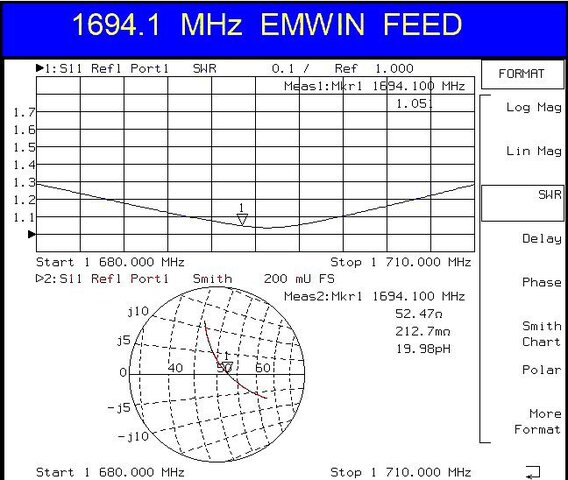 1694.1 EMWIN Feed.jpg93.3 KB · Views: 231
1694.1 EMWIN Feed.jpg93.3 KB · Views: 231 -
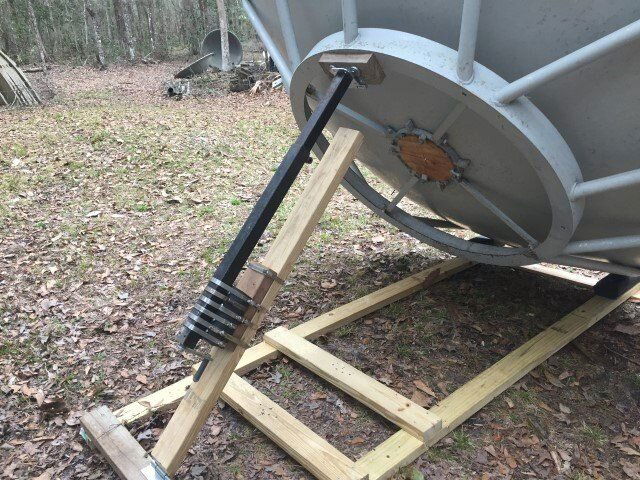 7.8-ft dish Support.jpg (Small).jpg103.8 KB · Views: 218
7.8-ft dish Support.jpg (Small).jpg103.8 KB · Views: 218 -
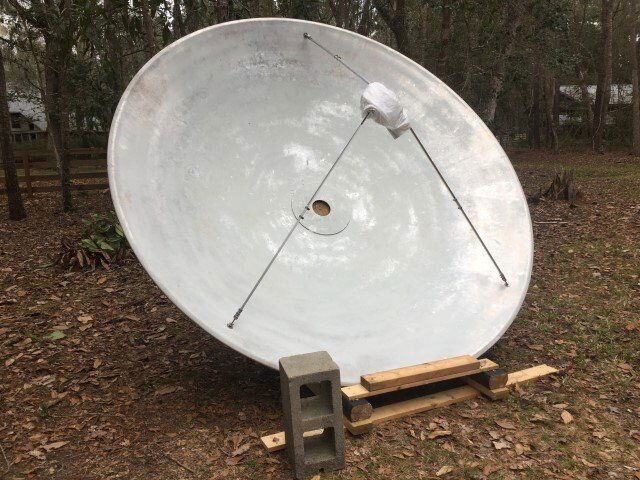 EMWIN 7.8-ft dish.jpg (Small).jpg79.5 KB · Views: 243
EMWIN 7.8-ft dish.jpg (Small).jpg79.5 KB · Views: 243 -
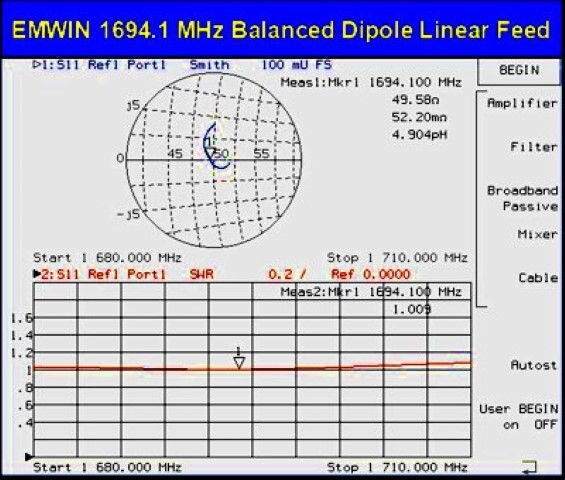 Modified 1694.1 MHz Feed.jpg (Small).jpg70.1 KB · Views: 227
Modified 1694.1 MHz Feed.jpg (Small).jpg70.1 KB · Views: 227 -
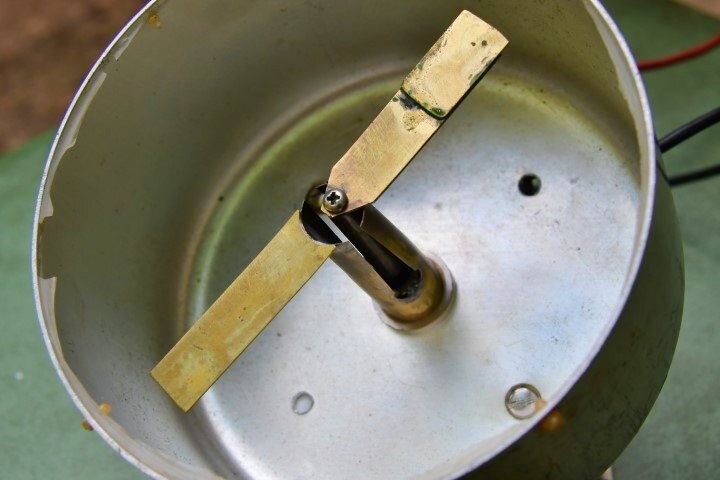 Modified balanced dipole.jpg.JPG57.8 KB · Views: 215
Modified balanced dipole.jpg.JPG57.8 KB · Views: 215 -
 MPB_0966 (Small).JPG77.1 KB · Views: 232
MPB_0966 (Small).JPG77.1 KB · Views: 232 -
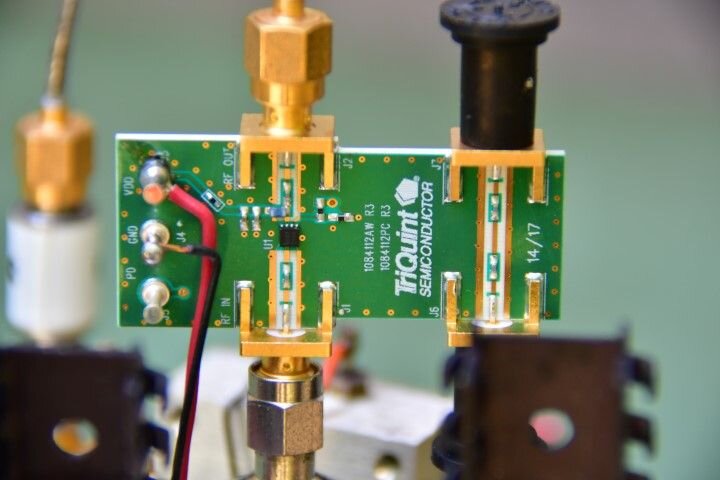 MPB_0967 (Small).JPG72.5 KB · Views: 240
MPB_0967 (Small).JPG72.5 KB · Views: 240 -
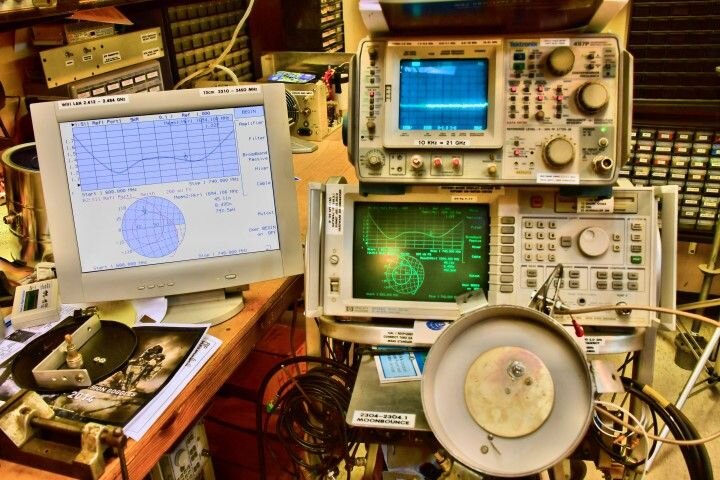 VNA on patch ant (Small).jpg113.4 KB · Views: 235
VNA on patch ant (Small).jpg113.4 KB · Views: 235 -
 IMG_0012 (Small).JPG82.7 KB · Views: 220
IMG_0012 (Small).JPG82.7 KB · Views: 220
Mike, you got some nice stuff.
I can tell you that the dipole won't work so we can eliminate that from the equation, no chance of circular polarization there..
If the the patch feed can do it the isolation between the polarities could be a problem but it may still work to a point.
Might be an option.
Tell us more about the EMWIN feed.
Is it the basic cantenna design?
Like a can 5" dia with a probe on one end. As we are calling it a cantenna.
If it is, then whatever you can get with it you must be able to do as good or better with any other feed. That would be a good start without having a DVB-S2 receiver..
I can't see much detail in the pics as satguys lowers the resolution of pictures of certain sizes and then you loose the detail.
I am not familiar with the NOAA polar orbiter 1690 Mhz feeds. I have never messed with those satellites at that frequency only at he 137 Mhz frequencies.
The septum feed has been proven to work, however you can get close with a design as we have been talking about throughout this forum that's much cheaper in the early design, certainly up to you.
Otherwise I would recommend that you get ready to purchase the Digital devices DD Cine card as the receiver. This is the most important tool that you will have to determine the signal's level and quality.
A better feed can be made later once you are able to see your signal details.
Unless.. you have access to a commercial DVB-S2 signal analyzer then you can use that to determine how well your setup is doing. Most of us don't have access to that.
I just came up with an idea, Mike do you have a NOAAPORT downlink there?
If you do.. NOAAPORT uses the DVB-S2 outer format that is used on the GRB signal, It will lock and show signal strength info on the GRB signal BUT it WILL NOT DECODE the GRB signal as the GRB stream is a different type of format then what is used on NOAAPORT.
When I did my setup I started out with an analyzer to see the signal, I had to use my NOAAPORT receiver (Novra S300) to get any detail on signal level and lock.
If you don't have a NOAAPORT downlink then get ready to buy the Digital Devices receiver card as it's the only one available that is known to work..
Brett, please check my link of the receiver card to be sure it's the right one, thanks.
I can tell you that the dipole won't work so we can eliminate that from the equation, no chance of circular polarization there..
If the the patch feed can do it the isolation between the polarities could be a problem but it may still work to a point.
Might be an option.
Tell us more about the EMWIN feed.
Is it the basic cantenna design?
Like a can 5" dia with a probe on one end. As we are calling it a cantenna.
If it is, then whatever you can get with it you must be able to do as good or better with any other feed. That would be a good start without having a DVB-S2 receiver..
I can't see much detail in the pics as satguys lowers the resolution of pictures of certain sizes and then you loose the detail.
I am not familiar with the NOAA polar orbiter 1690 Mhz feeds. I have never messed with those satellites at that frequency only at he 137 Mhz frequencies.
The septum feed has been proven to work, however you can get close with a design as we have been talking about throughout this forum that's much cheaper in the early design, certainly up to you.
Otherwise I would recommend that you get ready to purchase the Digital devices DD Cine card as the receiver. This is the most important tool that you will have to determine the signal's level and quality.
A better feed can be made later once you are able to see your signal details.
Unless.. you have access to a commercial DVB-S2 signal analyzer then you can use that to determine how well your setup is doing. Most of us don't have access to that.
I just came up with an idea, Mike do you have a NOAAPORT downlink there?
If you do.. NOAAPORT uses the DVB-S2 outer format that is used on the GRB signal, It will lock and show signal strength info on the GRB signal BUT it WILL NOT DECODE the GRB signal as the GRB stream is a different type of format then what is used on NOAAPORT.
When I did my setup I started out with an analyzer to see the signal, I had to use my NOAAPORT receiver (Novra S300) to get any detail on signal level and lock.
If you don't have a NOAAPORT downlink then get ready to buy the Digital Devices receiver card as it's the only one available that is known to work..
Brett, please check my link of the receiver card to be sure it's the right one, thanks.
Yes, the link you gave is the known working PCIe card. But the TBS6903 is better and also works for NOAAPort because it supports ACM/VCM. The Digital Devices does not. I use a TBS6983 which is an older version of the TBS6903....
Brett, please check my link of the receiver card to be sure it's the right one, thanks.
Okay... But have we actually tested the TBS6903 card for use in receiving GRB?But the TBS6903 is better and also works for NOAAPort because it supports ACM/VCM. The Digital Devices does not. I use a TBS6983 which is an older version of the TBS6903.
There have been a lot on model numbers that have been posted here I need to know for myself.
The ones I recall are older and no longer available the have been used/tested.
Yes. 'weather01089' has verified it on the chat board.Okay... But have we actually tested the TBS6903 card for use in receiving GRB?....
*************************Mike, you got some nice stuff.
I can tell you that the dipole won't work so we can eliminate that from the equation, no chance of circular polarization there..
If the the patch feed can do it the isolation between the polarities could be a problem but it may still work to a point.
Might be an option.
Tell us more about the EMWIN feed.
Is it the basic cantenna design?
Like a can 5" dia with a probe on one end. As we are calling it a cantenna.
If it is, then whatever you can get with it you must be able to do as good or better with any other feed. That would be a good start without having a DVB-S2 receiver..
I can't see much detail in the pics as satguys lowers the resolution of pictures of certain sizes and then you loose the detail.
I am not familiar with the NOAA polar orbiter 1690 Mhz feeds. I have never messed with those satellites at that frequency only at he 137 Mhz frequencies.
The septum feed has been proven to work, however you can get close with a design as we have been talking about throughout this forum that's much cheaper in the early design, certainly up to you.
Otherwise I would recommend that you get ready to purchase the Digital devices DD Cine card as the receiver. This is the most important tool that you will have to determine the signal's level and quality.
A better feed can be made later once you are able to see your signal details.
Unless.. you have access to a commercial DVB-S2 signal analyzer then you can use that to determine how well your setup is doing. Most of us don't have access to that.
I just came up with an idea, Mike do you have a NOAAPORT downlink there?
If you do.. NOAAPORT uses the DVB-S2 outer format that is used on the GRB signal, It will lock and show signal strength info on the GRB signal BUT it WILL NOT DECODE the GRB signal as the GRB stream is a different type of format then what is used on NOAAPORT.
When I did my setup I started out with an analyzer to see the signal, I had to use my NOAAPORT receiver (Novra S300) to get any detail on signal level and lock.
If you don't have a NOAAPORT downlink then get ready to buy the Digital Devices receiver card as it's the only one available that is known to work..
Brett, please check my link of the receiver card to be sure it's the right one, thanks.
Hi, Fred--
I knew that the dipole feed is useless for the GRB downlink. I built it for downlinking the EMWIN signal and it seems to be producing sufficient signal above the noise-floor to enable clean processing and display of the EMWIN content. Several commercial antennas for the EMWIN signal appear to consist of an approximately 1-meter grid-mesh parabolic reflector with a simple dipole and reflector element for the feed. I built my own (balanced) linear polarity dipole feed with integral balun as you see in the photos I posted to this forum thread. It turned out to look pretty good on the SWR and Smith Chart display from my VNA that I posted on this thread. It took a number of cut-and-try attempts to get the coaxial balun that the balanced dipole is sitting on top of to produce the right results.
I do have a copy of a commercial cantenna feed set up on the tracking dish for the polar orbit met-sats. I have thought about making another version of
Oh good, there are 2 choices for the receiver.Yes. 'weather01089' has verified it on the chat board.
Was that tested on Win 10 driver?
So there you go Mike, Magic anybody else out there, here are the options for receivers. Again I would consider getting a receiver before going too fancy with the feed.
.
Hi, Fred--
I knew that the dipole feed is useless for the GRB downlink. I built it for downlinking the EMWIN signal and it seems to be producing sufficient signal above the noise-floor to enable clean processing and display of the EMWIN content
Mike, if you're referring to me I'm Tim.
I follow you on that and those antennas work for that, It may work as well on HRIT. The old EMWIN N transmission is going away soon. Unless you are using GOES West then you might have it for the end of the year.
I was looking on the posts here and didn't see this so I will ask.
You show the analyzer display in some pictures of the GRB signal.
Here's the question:
What's the level in dB above the noise floor when you took that sample? (I may have overlooked it)
Also your post #533 seemed to be cut off in mid sentence.
I found it and it looks to be around 8 dB. I notice that your BW looks to be at 100 khz. When I did the display of mine the BW was 200 kHz (hard to read in the picture). The difference of the BW might affect the S/N dB amplitude measurement. Try to see if you can get the analyzer to 200 Khz BW then look at the S/N.What's the level in dB above the noise floor when you took that sample? (I may have overlooked it)
Hi--
I know nothing about the NOAAPORT signal except that it is downlinked from the SES Americom SES-1 Satellite, Transponder 13C. The satellite is located at 101 degrees West Longitude.
I just did a quickie cursory search for what products are carried on the NOAAPORT downlink but did not see a list of them.
I presume that a special receiver is needed to receive NOAAPORT. Hmmmmm.... How strong is the downlink signal footprint in Florida and what size dish is needed to provide error-free lock up here in Flori-DUH ?
I have a 2-meter prime-focus dish and some C-band and Ku-Band feeds with LNA and I.F. block down-converters. If a 2-meter dish is big enough and the cost for a NOAAPORT receiver is not too high I will try to cobble up a downlink for it.
Mike B in Micanopy, Fla
I know nothing about the NOAAPORT signal except that it is downlinked from the SES Americom SES-1 Satellite, Transponder 13C. The satellite is located at 101 degrees West Longitude.
I just did a quickie cursory search for what products are carried on the NOAAPORT downlink but did not see a list of them.
I presume that a special receiver is needed to receive NOAAPORT. Hmmmmm.... How strong is the downlink signal footprint in Florida and what size dish is needed to provide error-free lock up here in Flori-DUH ?
I have a 2-meter prime-focus dish and some C-band and Ku-Band feeds with LNA and I.F. block down-converters. If a 2-meter dish is big enough and the cost for a NOAAPORT receiver is not too high I will try to cobble up a downlink for it.
Mike B in Micanopy, Fla
It's now on Galaxy 89W as NOAA moved it from SES.I know nothing about the NOAAPORT signal except that it is downlinked from the SES Americom SES-1 Satellite, Transponder 13C. The satellite is located at 101 degrees West Longitude.
I will not go into details here about that as that's off the subject we are talking about.
I will start a conversation with you about that off the side of this discussion.
Okay, With out a Digital Video Broadcast seconded generation receiver you are going to have to get one to do much more with the GRB signal.
The two choices are this:
Digital devices DD Cine card
TBS6903 card
There may be a 3rd choice but it won't be out until July or after of this year. And it going to be more $$ then those two cards.
They are not really special compared to the GVAR receiver.I presume that a special receiver is needed to receive NOAAPORT
DVB-S2 is now the worldwide standard for satellite data transmission. Used mainly for TVRO sats it's been adapted to be used for the transfer of data streams. The receivers (or modem) are made by several and not just built for one purpose. This keeps the hardware cost down for users like us.
Look at the link for more info on the outer format used:
Digital Video Broadcast seconded generation
Please see post #550. That is why I recommend a TBS6903 over a Digital Devices card -- it works for both NOAAPORT and GRB. I can get both NOAAPort and GRB here in California with a 10 foot dish. It might also work with my 8.5' dish but I haven't tried it yet....
I presume that a special receiver is needed to receive NOAAPORT. Hmmmmm.... How strong is the downlink signal footprint in Florida and what size dish is needed to provide error-free lock up here in Flori-DUH ?...
Both NOAAPort and GRB need GRBStreamer to read from the DVB card and stream it via UDP to an image processing program. I wrote GRBStreamer and offer it at no charge to anyone who requests it.
The verdict is in:
Got the new feed Brett
Installed it and connected the Sawbird with the USB battery pack.
Also had another amp that has DC blocking abilities in line and it's also needed for signal level. It was on Battery as well.
TBS 5927 for the receiver.
Dish set on GOES S
results:

No Change.
Both here and with GRBStreamer. Didn't even try the Omnicom as I figured that the results there will be the same.
I now say it's a receiver problem. My feed may work as thought.
I'll be eager to hear any comments.
Got the new feed Brett
Installed it and connected the Sawbird with the USB battery pack.
Also had another amp that has DC blocking abilities in line and it's also needed for signal level. It was on Battery as well.
TBS 5927 for the receiver.
Dish set on GOES S
results:
No Change.
Both here and with GRBStreamer. Didn't even try the Omnicom as I figured that the results there will be the same.
I now say it's a receiver problem. My feed may work as thought.
I'll be eager to hear any comments.
Similar threads
- Replies
- 4
- Views
- 728
- Replies
- 8
- Views
- 2K
- Replies
- 2
- Views
- 1K
- Replies
- 2
- Views
- 709
Users Who Are Viewing This Thread (Total: 2, Members: 0, Guests: 2)
Who Read This Thread (Total Members: 64) Show all
- GOES 12 GVAR user
- th3badwolf
- WhyLow
- rommac100
- k4otl
- catamount
- jorgek
- mr_rye89
- a33
- 1oldman123
- texanboy
- Titanium
- one_db_compression
- Elsguy
- voomvoom
- Mr Tony
- K3dmurphy
- freddylq
- juventusbrown
- waylew
- cyberham
- clucas
- mikekohl
- arlo
- N6BY
- bcwmachine
- FTA4PA
- b4pjoe
- N5XZS
- LazzSnazz
- lost_mesa
- raoul5788
- phlatwound
- Ronnie-
- KyL416
- KE4EST
- primestar31
- brice52
- teachsac
- wds657
- sat_cat_25
- Former member 208376
- Grashoper
- TvSteve
- mc6809e
- stecle
- DangerousDyke
- ghulands
- caramel
- Arion
- lonelyfool123
- c-spand
- PrunePicker
- wagonman76
- weather01089
- byron
- Lajaba
- kps
- tgro870
- fireball517
- DarrylZ

